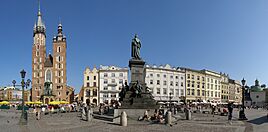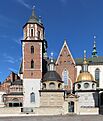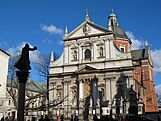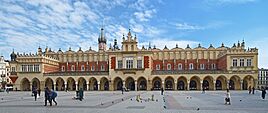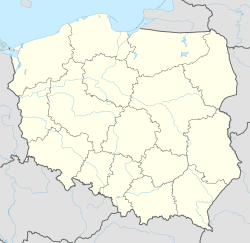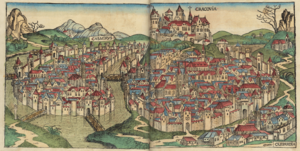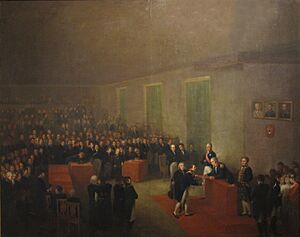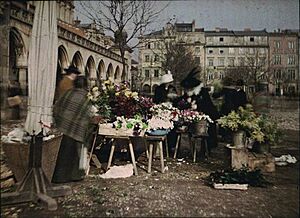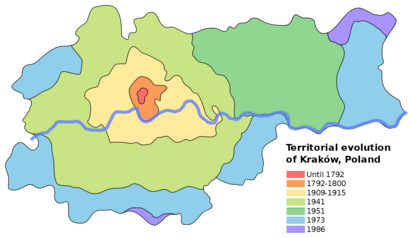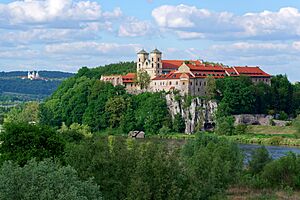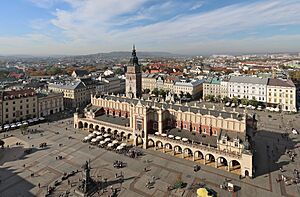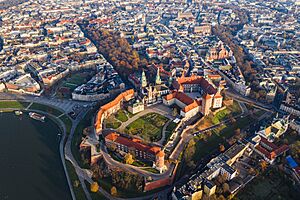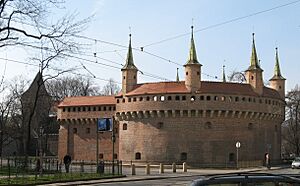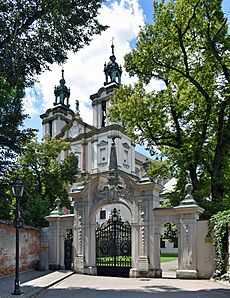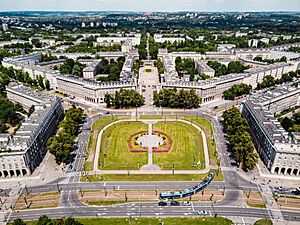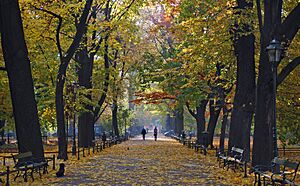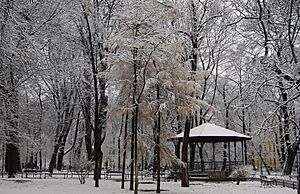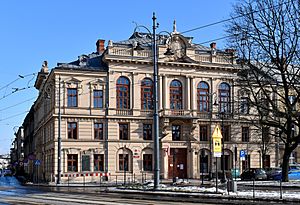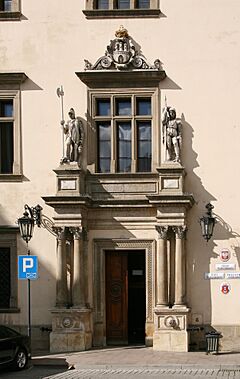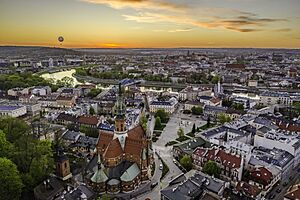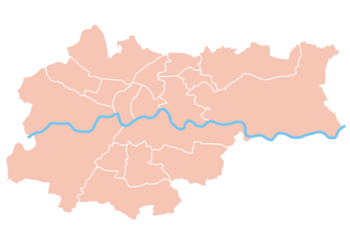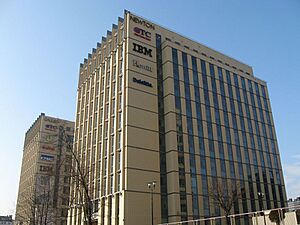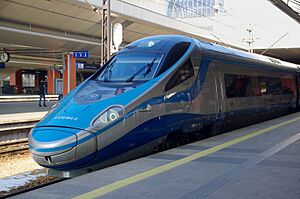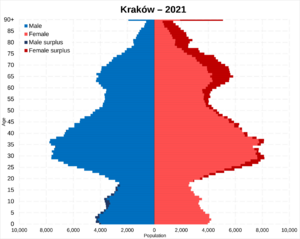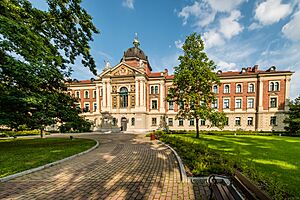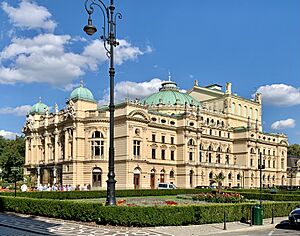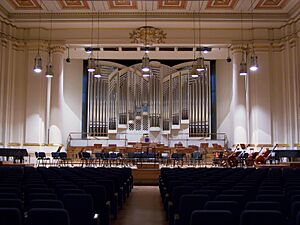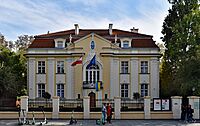- This page was last modified on 17 October 2025, at 10:18. Suggest an edit.
Kraków facts for kids
|
Kraków
Cracow
|
|||||
|---|---|---|---|---|---|
| Royal Capital City of Kraków Polish: Stołeczne Królewskie Miasto Kraków |
|||||
|
St. Mary's Basilica and the Mickiewicz Monument
Wawel Cathedral
Saints Peter and Paul Church
Wawel Castle
Floriańska Street
Cloth Hall at Main Square
|
|||||
|
|||||
| Motto(s):
Cracovia urbs celeberrima
|
|||||
| Country | |||||
| Voivodeship | |||||
| City rights | 5 June 1257 | ||||
| City Hall | Wielopolski Palace | ||||
| Districts | 18 districts | ||||
| Government | |||||
| • Type | Mayor–council government | ||||
| • Body | Kraków City Council | ||||
| Area | |||||
| • City | 326.8 km2 (126.2 sq mi) | ||||
| • Metro | 4,065.11 km2 (1,569.55 sq mi) | ||||
| Highest elevation | 383 m (1,257 ft) | ||||
| Lowest elevation | 187 m (614 ft) | ||||
| Population
(30 June 2023)
|
|||||
| • City | |||||
| • Density | 2,461/km2 (6,370/sq mi) | ||||
| • Metro | 1,498,499 | ||||
| • Metro density | 368.6245/km2 (954.7330/sq mi) | ||||
| Demonym(s) | Cracovian | ||||
| GDP | |||||
| • City | €18.031 billion (2020) | ||||
| • Metro | €25.534 billion (2020) | ||||
| Time zone | UTC+1 (CET) | ||||
| • Summer (DST) | UTC+2 (CEST) | ||||
| Postal code |
30-024 to 31–963
|
||||
| Area code(s) | +48 12 | ||||
| International airport | Kraków John Paul II (KRK) | ||||
| Official name: Historic Centre of Kraków | |||||
| Type: | Cultural | ||||
| Criteria: | IV | ||||
| Designated: | 1978 (2nd session) | ||||
| Reference #: | 29 | ||||
| UNESCO region: | Europe | ||||
Kraków (also called Cracow or Krakow) is the second-largest and one of the oldest cities in Poland. It sits on the Vistula River in the Lesser Poland Voivodeship. About 804,237 people live there (as of 2023). Many more people live nearby.
Kraków was the capital of Poland until 1596. It has always been a major center for learning, culture, and art in Poland. People often call it one of Europe's most beautiful cities. Its Old Town became a UNESCO World Heritage Site in 1978. This was one of the very first places in the world to get this special status.
The city started as a small village on Wawel Hill. By 985, it was a busy trading hub in Central Europe. In 1038, it became the home of Polish monarchs. It stayed an important center until the late 1500s. That's when King Sigismund III moved his royal court to Warsaw.
After World War I, in 1918, Kraków became important again for Poland's national spirit. During World War II, the city was taken over by Nazi Germany. Jewish people were forced into the Kraków Ghetto. From there, they were sent to extermination camps like Auschwitz. Luckily, the city itself was saved from being destroyed. In 1978, Karol Wojtyła, who was the archbishop of Kraków, became Pope John Paul II. He was the first non-Italian pope in 455 years.
Kraków's Old Town and historic center are Poland's first World Heritage Sites. The city has amazing buildings from different times, like Gothic, Renaissance, and Baroque architecture. These include Wawel Cathedral and Wawel Royal Castle. You can also see St. Mary's Basilica and Saints Peter and Paul Church. The Main Square is Europe's largest medieval market square.
Kraków is home to Jagiellonian University. It is one of the oldest universities in the world. Many people think it is Poland's best university. The city also has important places like the National Museum and the Kraków Opera.
Kraków is known as a "global city." This means it's an important city for worldwide connections. John Paul II International Airport serves the city. It's Poland's second busiest airport. In 2000, Kraków was named a European Capital of Culture. In 2013, it became a UNESCO City of Literature. The city hosted World Youth Day in 2016. It also hosted the European Games in 2023.
Contents
City Name and Meaning
The name Kraków likely comes from Krakus. He was a legendary founder of the city. He was also a ruler of the Vistulans tribe. In Polish, Kraków means "Krak's town." Historians still debate the exact origin of the name. Some think it might come from the Polish word kruk, meaning 'crow' or 'raven'.
The city's full official name is Stołeczne Królewskie Miasto Kraków. This means "Royal Capital City of Kraków." People from Kraków are called Cracovians.
Kraków's Long History
Early Beginnings and Medieval Times
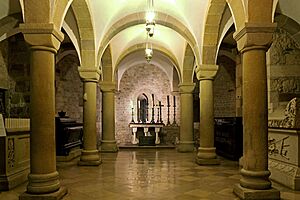
The Romanesque St. Leonard's Crypt is from the 11th century. This was when Casimir I the Restorer made Kraków his royal home and Poland's capital.
Kraków's history started with a Stone Age settlement. This was on what is now Wawel Hill. A legend says that the mythical ruler Krakus founded Kraków. He built it above a cave where a dragon, Smok Wawelski, lived. The first time Kraków's name was written down was in 965. It was described as an important trading center.
In 1038, Kraków became the center of the Polish government. By the late 900s, it was a top trading city. Brick buildings were built, like the Royal Wawel Castle. There were also Romanesque churches and a cathedral.
In 1241, the city was attacked and burned during a Mongol invasion. It was rebuilt almost exactly the same way. In 1257, Duke Bolesław V the Chaste gave Kraków city rights. This brought tax benefits and new trade rules. The Mongols attacked again in 1259. A third attack in 1287 was stopped by new city walls.
In 1335, King Casimir III the Great created a new city. He named it Kazimierz after himself. In 1364, Casimir founded the University of Kraków. This was the second oldest university in Central Europe.
The city continued to grow under the Jagiellonian dynasty. Kraków was the capital of Poland. It was also part of the Hanseatic League, a group of trading cities. Many skilled workers came to live and work there. Science and arts began to thrive.
The Golden Age and Later Changes
The 1400s and 1500s were Poland's "Golden Age." Many beautiful Polish Renaissance artworks and buildings were made. This included old synagogues in Kraków's Jewish quarter in Kazimierz. Artists like Hans Dürer and Hans von Kulmbach worked in Kraków. The famous Zygmunt church bell was cast in 1520.
In 1596, King Sigismund III moved the capital from Kraków to Warsaw. This made Kraków less important. In the 1650s, the city was damaged during the Swedish invasion. In 1707, a serious disease caused 20,000 deaths.
19th Century Transformations
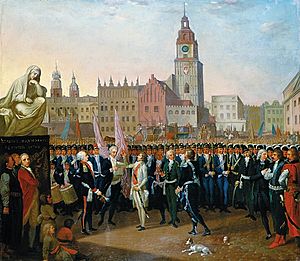
Tadeusz Kościuszko taking an oath in Kraków's market square in 1794.
In the late 1700s, Poland was divided by its neighbors: Russia, Austria, and Prussia. In 1791, Kazimierz became part of Kraków. In 1794, Tadeusz Kościuszko started an uprising in Kraków's Main Square. This uprising failed. Kraków then came under Austrian rule.
In 1802, German became the official language. In 1809, Napoleon Bonaparte made Kraków part of the Duchy of Warsaw. After Napoleon's defeat, the Congress of Vienna in 1815 created the Free City of Kraków. This was a partly independent city-state. It was the only part of Poland that was still free between 1815 and 1846.
During this time, Kraków's population grew. But political problems led to the Kraków uprising in 1846. Austria crushed the uprising. The Free City was then taken over by the Austrian Empire.
In 1866, Austria gave Galicia some freedom. Kraków became a symbol of Polish culture and art. Many famous Polish artists lived there. The city grew into a modern place. Running water and electric streetcars arrived in 1901. Between 1910 and 1915, Kraków and its suburbs joined to form "Greater Kraków."
When World War I started in 1914, Józef Piłsudski formed a military unit in Kraków. They fought for Poland's freedom. Austrian rule in Kraków ended in 1918.
20th Century to Today
After Poland became independent in 1918, Kraków became a major academic and cultural center again. New universities and schools were built. It was also an important center for Polish Jews.
In September 1939, Nazi Germany invaded Poland. Kraków became the capital of the "General Government," a Nazi-controlled area. Hans Frank ruled from Wawel Castle. The Nazis wanted to make Kraków a German city. They forced Jewish people into the Kraków Ghetto. From there, many were sent to extermination camps like Auschwitz.
The film director Roman Polanski survived the Kraków Ghetto. Oskar Schindler saved many Jewish people by hiring them to work in his factory. Kraków was mostly undamaged at the end of World War II. Soviet forces entered the city in January 1945.
After the war, under Communist rule, Kraków's universities lost some freedom. The government built a huge steel mill in the new suburb of Nowa Huta. This changed Kraków from a university city to an industrial one.
Karol Wojtyła, the archbishop of Kraków, worked for twenty years to get permission to build new churches. In 1978, he became Pope John Paul II. In the same year, UNESCO added Kraków Old Town to its list of World Heritage Sites.
City Geography
Kraków is in southern Poland, on the Vistula River. It is about 219 meters (719 feet) above sea level. The city is located where different land regions meet. These include uplands to the north and foothills of the Carpathians to the south.
Kraków has five nature reserves. These areas are protected because of their special plants and animals. The western part of the city is near the Jurassic Bielany-Tyniec refuge. This area is important for its wildlife and land features. The Vistula River valley is also an important ecological area.
Kraków's Climate

The Convent of Norbertine Sisters in Kraków-Zwierzyniec and the Vistula River in summer.
Kraków has a climate that is a mix of humid subtropical and humid continental. This means it has hot summers. In recent years, temperatures have risen. Summer days above 30°C (86°F) are now common.
Because of its location, Kraków's weather can change quickly. It can be influenced by marine air or even Arctic air. The city is also close to the Tatra Mountains. Sometimes, a warm wind called halny blows, making temperatures rise fast.
| Climate data for Kraków-Airport (KRK), 1991–2020 normals, extremes 1951–present | |||||||||||||
|---|---|---|---|---|---|---|---|---|---|---|---|---|---|
| Month | Jan | Feb | Mar | Apr | May | Jun | Jul | Aug | Sep | Oct | Nov | Dec | Year |
| Record high °C (°F) | 16.6 (61.9) |
19.8 (67.6) |
24.1 (75.4) |
30.0 (86.0) |
32.6 (90.7) |
34.2 (93.6) |
35.7 (96.3) |
37.3 (99.1) |
34.8 (94.6) |
27.1 (80.8) |
22.5 (72.5) |
19.3 (66.7) |
37.3 (99.1) |
| Mean maximum °C (°F) | 10.0 (50.0) |
12.3 (54.1) |
18.0 (64.4) |
24.3 (75.7) |
27.9 (82.2) |
31.1 (88.0) |
32.5 (90.5) |
32.2 (90.0) |
27.6 (81.7) |
23.4 (74.1) |
17.3 (63.1) |
10.9 (51.6) |
33.8 (92.8) |
| Mean daily maximum °C (°F) | 1.6 (34.9) |
3.7 (38.7) |
8.4 (47.1) |
15.1 (59.2) |
19.8 (67.6) |
23.2 (73.8) |
25.3 (77.5) |
25.0 (77.0) |
19.5 (67.1) |
14.0 (57.2) |
7.6 (45.7) |
2.7 (36.9) |
13.8 (56.8) |
| Daily mean °C (°F) | −1.6 (29.1) |
−0.2 (31.6) |
3.5 (38.3) |
9.3 (48.7) |
14.0 (57.2) |
17.6 (63.7) |
19.3 (66.7) |
18.9 (66.0) |
13.9 (57.0) |
8.8 (47.8) |
3.8 (38.8) |
−0.5 (31.1) |
8.9 (48.0) |
| Mean daily minimum °C (°F) | −4.7 (23.5) |
−3.7 (25.3) |
−0.8 (30.6) |
3.7 (38.7) |
8.5 (47.3) |
12.2 (54.0) |
13.8 (56.8) |
13.4 (56.1) |
9.2 (48.6) |
4.7 (40.5) |
0.6 (33.1) |
−3.4 (25.9) |
4.5 (40.1) |
| Mean minimum °C (°F) | −15.7 (3.7) |
−13.0 (8.6) |
−8.0 (17.6) |
−3.0 (26.6) |
1.9 (35.4) |
6.6 (43.9) |
8.3 (46.9) |
7.7 (45.9) |
2.8 (37.0) |
−3.2 (26.2) |
−7.3 (18.9) |
−13.5 (7.7) |
−18.0 (−0.4) |
| Record low °C (°F) | −29.9 (−21.8) |
−29.5 (−21.1) |
−26.7 (−16.1) |
−7.5 (18.5) |
−3.2 (26.2) |
−0.1 (31.8) |
5.4 (41.7) |
2.7 (36.9) |
−3.1 (26.4) |
−7.4 (18.7) |
−17.2 (1.0) |
−29.5 (−21.1) |
−29.9 (−21.8) |
| Average precipitation mm (inches) | 37.9 (1.49) |
32.3 (1.27) |
38.1 (1.50) |
46.4 (1.83) |
79.0 (3.11) |
77.0 (3.03) |
98.2 (3.87) |
72.5 (2.85) |
65.8 (2.59) |
51.2 (2.02) |
41.4 (1.63) |
33.4 (1.31) |
673.0 (26.50) |
| Average extreme snow depth cm (inches) | 7.6 (3.0) |
6.5 (2.6) |
2.7 (1.1) |
0.9 (0.4) |
0.0 (0.0) |
0.0 (0.0) |
0.0 (0.0) |
0.0 (0.0) |
0.0 (0.0) |
0.3 (0.1) |
2.7 (1.1) |
4.1 (1.6) |
7.6 (3.0) |
| Average precipitation days (≥ 0.1 mm) | 16.93 | 15.71 | 15.00 | 12.87 | 14.97 | 13.37 | 15.00 | 12.00 | 12.07 | 13.40 | 14.67 | 15.77 | 171.74 |
| Average snowy days (≥ 0 cm) | 17.9 | 14.1 | 5.5 | 0.8 | 0.0 | 0.0 | 0.0 | 0.0 | 0.0 | 0.3 | 4.3 | 11.9 | 54.8 |
| Average relative humidity (%) | 85.8 | 82.5 | 76.3 | 69.9 | 72.0 | 72.7 | 73.2 | 74.5 | 80.2 | 83.8 | 87.7 | 87.5 | 78.8 |
| Mean monthly sunshine hours | 43.3 | 63.2 | 100.5 | 136.9 | 200.8 | 193.5 | 210.5 | 200.7 | 125.4 | 97.7 | 48.8 | 32.1 | 1,453.4 |
| Source 1: Institute of Meteorology and Water Management | |||||||||||||
| Source 2: Meteomodel.pl (records, relative humidity 1991–2020, sunshine 1971–2000) | |||||||||||||
| Climate data for Kraków-Observatory, 1991–2020 normals, extremes 1951–present | |||||||||||||
|---|---|---|---|---|---|---|---|---|---|---|---|---|---|
| Month | Jan | Feb | Mar | Apr | May | Jun | Jul | Aug | Sep | Oct | Nov | Dec | Year |
| Record high °C (°F) | 17.3 (63.1) |
21.0 (69.8) |
24.7 (76.5) |
31.2 (88.2) |
33.7 (92.7) |
36.0 (96.8) |
36.7 (98.1) |
38.3 (100.9) |
35.8 (96.4) |
27.9 (82.2) |
24.0 (75.2) |
19.9 (67.8) |
38.3 (100.9) |
| Mean maximum °C (°F) | 10.9 (51.6) |
13.3 (55.9) |
18.9 (66.0) |
25.3 (77.5) |
28.9 (84.0) |
32.1 (89.8) |
33.4 (92.1) |
33.2 (91.8) |
28.4 (83.1) |
24.4 (75.9) |
17.8 (64.0) |
11.6 (52.9) |
34.7 (94.5) |
| Mean daily maximum °C (°F) | 2.3 (36.1) |
4.4 (39.9) |
9.1 (48.4) |
15.8 (60.4) |
20.6 (69.1) |
24.0 (75.2) |
26.0 (78.8) |
25.8 (78.4) |
20.2 (68.4) |
14.6 (58.3) |
8.2 (46.8) |
3.3 (37.9) |
14.5 (58.1) |
| Daily mean °C (°F) | −1.0 (30.2) |
0.4 (32.7) |
4.1 (39.4) |
9.8 (49.6) |
14.6 (58.3) |
18.3 (64.9) |
20.0 (68.0) |
19.3 (66.7) |
14.2 (57.6) |
9.2 (48.6) |
4.4 (39.9) |
0.2 (32.4) |
9.5 (49.1) |
| Mean daily minimum °C (°F) | −3.5 (25.7) |
−2.6 (27.3) |
0.3 (32.5) |
4.8 (40.6) |
9.5 (49.1) |
13.2 (55.8) |
14.9 (58.8) |
14.4 (57.9) |
10.1 (50.2) |
5.7 (42.3) |
1.7 (35.1) |
−2.2 (28.0) |
5.5 (41.9) |
| Mean minimum °C (°F) | −14.0 (6.8) |
−11.4 (11.5) |
−6.4 (20.5) |
−1.6 (29.1) |
3.0 (37.4) |
8.1 (46.6) |
9.9 (49.8) |
9.2 (48.6) |
3.8 (38.8) |
−1.8 (28.8) |
−5.8 (21.6) |
−11.6 (11.1) |
−16.4 (2.5) |
| Record low °C (°F) | −26.1 (−15.0) |
−26.8 (−16.2) |
−23.2 (−9.8) |
−4.6 (23.7) |
−1.8 (28.8) |
2.3 (36.1) |
6.6 (43.9) |
4.5 (40.1) |
−2.6 (27.3) |
−5.7 (21.7) |
−16.1 (3.0) |
−25.7 (−14.3) |
−26.8 (−16.2) |
| Average precipitation mm (inches) | 37.9 (1.49) |
33.3 (1.31) |
38.3 (1.51) |
48.4 (1.91) |
82.6 (3.25) |
81.1 (3.19) |
98.6 (3.88) |
75.1 (2.96) |
70.3 (2.77) |
53.1 (2.09) |
41.8 (1.65) |
32.4 (1.28) |
693.0 (27.28) |
| Average precipitation days (≥ 0.1 mm) | 16.9 | 15.2 | 14.9 | 12.9 | 14.6 | 13.8 | 14.7 | 12.4 | 12.0 | 13.6 | 14.7 | 16.3 | 172.0 |
| Average relative humidity (%) | 82.2 | 78.9 | 73.0 | 66.1 | 68.4 | 68.9 | 70.0 | 72.4 | 79.3 | 82.7 | 84.8 | 83.9 | 75.9 |
| Source: https://meteomodel.pl/dane/srednie-miesieczne | |||||||||||||
Environmental Concerns
Kraków and its surroundings are in a valley. This means the city often has bad air pollution. This is caused by smog, especially in winter. It comes from burning coal for heating homes.
City Landmarks and Architecture
Kraków shows off many historic building styles. These include Gothic, Renaissance, and Baroque architecture. Talented artists and builders from Italy and Germany helped create these amazing buildings.
Kraków's historic center is a UNESCO World Heritage Site. It includes the Old Town, the Main Market Square, the Cloth Hall, and the Barbican. It also features St. Florian's Gate, Kazimierz, and the Wawel Castle. The city's center is surrounded by Planty Park. It still has its medieval street layout.
Kraków was the royal capital of Poland for centuries. The Royal Road was the path taken by kings for their coronations. Some important buildings were lost over time. But the Gothic Town Hall Tower, 70 meters (230 feet) tall, still stands.
The Kazimierz district is famous for its many Renaissance buildings. It also has a historic Jewish quarter. Kazimierz was founded in the 1300s. It became a rich area with grand buildings. A bridge once connected Kazimierz to the Old Town. This bridge was important for trade.
By the 1930s, Kraków had 120 registered synagogues. Most of them were destroyed during World War II by the Nazis. After the war, the Jewish population was very small. Recently, many synagogues have been restored. Kazimierz is now a popular area with Jewish-themed shops and restaurants.
As Kraków grew under the Austro-Hungarian Empire, new building styles appeared. Key buildings from the 1800s and early 1900s include the Jan Matejko Academy of Fine Arts. Many new government buildings and homes were built. Polish architects trained in Vienna planned much of the city's growth.
After Poland became independent again, new modern buildings were planned. After World War II, the Communist government built in a Stalinist style. This was seen in the new industrial district of Nowa Huta. It had apartment blocks with wide, tree-lined streets.
After the fall of communism, many new buildings were completed. These include business parks and shopping centers like the Galeria Krakowska. There are also modern cultural buildings. An example is the Manggha Museum of Japanese Art and Technology.
Parks and Gardens
Kraków has about 40 parks, plus many gardens and forests. Some, like Planty Park and the Botanical Garden, are in the city center. Parks cover about 318.5 hectares (787 acres) of the city.
The most famous park is Planty Park. It was created between 1822 and 1830. It replaced the old city walls. It forms a green belt around the Old Town. The park is 21 hectares (52 acres) and 4 kilometers (2.5 miles) long. It's a popular walking path for people in Kraków.
Jordan Park, founded in 1889, was the first public park of its kind in Europe. It had running tracks, playgrounds, and a swimming pool.
City Government
The Kraków City Council has 43 elected members. One of them is the mayor, or President of Kraków. The mayor is elected every four years. The current mayor, Jacek Majchrowski, was re-elected for his fourth term in 2014.
The mayor's jobs include making and carrying out plans for the city. They also manage the city budget and prepare for floods. The mayor works with the City Council and city managers. In the 1990s, the city government was changed. This was to make sure political and administrative jobs were clear.
In 2000, the city started a "Safer City" program. This helped reduce crime. The city works with police, social services, and schools on this program.
City Districts
Kraków is divided into 18 administrative districts. Each district has some control over its own local government. Before 1991, the city had four main parts. These were Podgórze, Nowa Huta, Krowodrza, and the old city center.
The oldest parts of Kraków joined the city before the late 1700s. These include the Old Town (Stare Miasto). It was once inside the city walls. Now, Planty Park surrounds it. The Wawel District has the Royal Castle and the cathedral. Stradom and Kazimierz also have historic Jewish quarters.
Major districts added later include Podgórze and Nowa Huta. Podgórze was a separate town until 1915. Nowa Huta was built after World War II.
The Old Town district has about six thousand historic sites. It also has over two million works of art. Its buildings show many styles, like Romanesque, Renaissance, Baroque, and Gothic. Kraków's palaces, churches, and mansions are full of color and details.
In the Market Square, you'll find the Gothic St. Mary's Basilica. It was rebuilt in the 1300s. It has the famous wooden altar by Veit Stoss. A trumpet call (hejnał mariacki) is played every hour from the church's main tower. Legend says the tune was played during a 13th-century attack. A guard warned citizens, but he was shot by an archer. The tune stopped when he died. This story is in the book The Trumpeter of Krakow.
| District | Population | Area (2009) |
|---|---|---|
| Stare Miasto (I) | 41,121 | 559.29 ha (5.5929 km2) |
| Grzegórzki (II) | 30,441 | 586.18 ha (5.8618 km2) |
| Prądnik Czerwony (III) | 46,621 | 638.82 ha (6.3882 km2) |
| Prądnik Biały (IV) | 66,649 | 2,370.55 ha (23.7055 km2) |
| Krowodrza (V) | 34,467 | 538.32 ha (5.3832 km2) |
| Bronowice (VI) | 22,467 | 957.98 ha (9.5798 km2) |
| Zwierzyniec (VII) | 20,243 | 2,866.9 ha (28.669 km2) |
| Dębniki (VIII) | 56,258 | 4,671.11 ha (46.7111 km2) |
| Łagiewniki-Borek Fałęcki (IX) | 15,014 | 573.9 ha (5.739 km2) |
| Swoszowice (X) | 20,641 | 2,416.73 ha (24.1673 km2) |
| Podgórze Duchackie (XI) | 52,522 | 1,065.24 ha (10.6524 km2) |
| Bieżanów-Prokocim (XII) | 63,270 | 1,846.93 ha (18.4693 km2) |
| Podgórze (XIII) | 32,050 | 2,516.07 ha (25.1607 km2) |
| Czyżyny (XIV) | 26,169 | 1,229.44 ha (12.2944 km2) |
| Mistrzejowice (XV) | 54,276 | 547.82 ha (5.4782 km2) |
| Bieńczyce (XVI) | 44,237 | 369.43 ha (3.6943 km2) |
| Wzgórza Krzesławickie (XVII) | 20,234 | 2,375.82 ha (23.7582 km2) |
| Nowa Huta (XVIII) | 58,320 | 6,552.52 ha (65.5252 km2) |
| Total | 760,700 | 32,680.00 ha (326.8000 km2) |
The current districts were set up in 1995. They are numbered with Roman numerals and have names.
Map of districts of the City of Kraków
IV
VI
VII
V
I
II
IX
III
XVII
X
VIII
XI
XII
XIII
XIV
XVIII
XV
XVI
Interactive map. For more information, click on district number.
Kraków's Economy
Kraków is a very important economic center in Poland. Since the end of communism, private businesses have grown a lot. There are about 50 large international companies in the city. These include Google, Uber, IBM, and Shell. Kraków is also home to Comarch, a software company.
Kraków is the second most visited city in Poland. A report in 2011 said Kraków was a top city for global business projects. The city's budget for 2011 was about 3.5 billion złoty. Most of the money came from taxes and national funds. A large part of the budget goes to education and childcare. The city has a good financial rating. About 60% of its people are under 45 years old.
The Unity Tower was finished in 2020. It is now a new business and living center. It is the second-tallest building in Kraków.
Transportation in Kraków
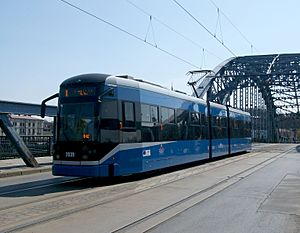
A Bombardier city tram on Piłsudski Bridge.
Public transport in Kraków uses a network of trams and buses. A city company runs these, along with private minibus operators. There is no subway system, but one is planned. Local trains connect some suburbs. The historic city center is mostly for walking. You can also find rickshaws and horse-drawn carriages.
You can travel by train to most Polish cities. You can also go to other countries like Bratislava, Budapest, and Berlin. The main railway station is just outside the Old Town. It's easy to reach by public transport.
Kraków's airport is called Kraków John Paul II International Airport. It is 11 kilometers (7 miles) west of the city. Direct trains go from the main train station to the airport in 20 minutes. In 2017, about 5.8 million people used the airport.
In 2016, Kraków's bike-sharing system was updated. It now has 1,500 bikes at 169 stations. It's called Wavelo.
Kraków's People
Kraków had 774,839 people in 2019. This grew to 804,237 in 2023. The larger area around the city had about 1.4 million people in 2010.
In the Middle Ages, Kraków's population grew fast. It had many different ethnic groups. In 1931, before World War II, most people spoke Polish. About 20.9% spoke Yiddish or Hebrew. War greatly reduced the number of ethnic minorities.
In the last 20 years, many immigrants have moved to Kraków. In 2019, about 10% of the city's population were foreigners. Most of them were from Ukraine.
| Nationality | Population |
|---|---|
| 45,100 | |
| 5,975 | |
| 3,640 | |
| 2,636 | |
| 2,221 | |
| 1,512 |
- Population growth in Kraków since 1791

Religion in Kraków
Religion in Krakow (2021) Catholicism (58%) Protestantism (0.5%) Other Christian (0.2%) Other (0.01%) Irreligion (14%) Undeclared (27%)
Kraków is known as the "city of churches." It has over 120 places of worship. Many were built in the 20th century. Besides Roman Catholicism, there are also other Christian groups. These include Jehovah's Witnesses and Protestants.
Kraków also has many historic Jewish temples. Before World War II, Kraków was a big center for Jewish life. There were at least 90 synagogues. Most of them were ruined during the war by the Nazis. After the war, the Jewish population was much smaller. Many synagogues have been restored recently. They are used for religious services and for tourists.
Education in Kraków
Kraków is a major education hub. There are 24 universities and colleges in the city. More than 200,000 students study here. Jagiellonian University is the oldest university in Poland. It was founded in 1364. It has over 4 million books in its library. Famous people like Nicolaus Copernicus and Pope John Paul II studied here.
AGH University of Science and Technology is Poland's largest technical university. It was started in 1919. It has over 30,000 students.
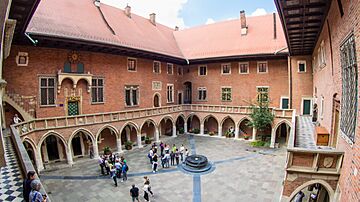
Collegium Maius, Jagiellonian University's oldest building.
Other important schools include:
- Academy of Music in Kraków: One of the oldest music schools in Central Europe.
- Kraków University of Economics: Started in 1925.
- Jan Matejko Academy of Fine Arts: The oldest art academy in Poland.
Many scientific groups also work in Kraków. They do research and educational work.
Kraków's Culture
Kraków was named the official European Capital of Culture in 2000. Important landmarks include the Main Market Square with St. Mary's Basilica. There's also the Sukiennice Cloth Hall and the Wawel Castle. The Czartoryski Museum has art by Leonardo da Vinci and Rembrandt.
Museums and Art Galleries

The National Museum in Kraków is one of Poland's best art galleries.
Kraków has about 82 museums and art galleries. The National Museum was started in 1879. The Royal Chambers at Wawel show art and old furniture. They also have a large collection of 16th-century tapestries.
The Rynek Underground museum is under the city's main square. It shows Kraków's history over 1,000 years. The Polish Aviation Museum is considered one of the world's best aviation museums. It has over 200 aircraft.
Performing Arts
The city has several famous theaters. These include the Narodowy Stary Teatr and the Juliusz Słowacki Theatre. The Opera Krakowska puts on 200 shows each year. These include ballet, operettas, and musicals. The main concert hall is the Kraków Philharmonic.
Kraków hosts many art events every year. Some are internationally known. These include the Misteria Paschalia (Baroque music) and the Kraków Film Festival. Kraków was home to two Polish Nobel winners in literature: Wisława Szymborska and Czesław Miłosz.
Music Scene
Opera Krakowska is a leading opera company. It performs many world and Polish opera classics. Kraków also hosts two major festivals for early music.
The Academy of Music in Kraków was founded in 1888. It is famous as the school of composer Krzysztof Penderecki. The academy holds concerts all year round.
Tourism in Kraków
In 2019, over 14 million tourists visited Kraków. About 3.3 million were from other countries. They spent over 7.5 billion zloty (about €1.7 billion) in the city. Most foreign tourists came from Germany, the United Kingdom, and Italy.
People visit Kraków for its historic places and for fun. They also come to see relatives and friends. There are 120 hotels in Kraków. The average stay is about 4 to 7 nights. Tourists often say they like the city's friendly atmosphere.
Places to visit outside the city include the Wieliczka Salt Mine. The Tatra Mountains are 100 kilometers (62 miles) to the south. You can also visit the former Nazi concentration camp at Auschwitz. Ojcowski National Park has a Renaissance castle. Kraków has won many international awards as a top city to visit.
Sports in Kraków
Football is the most popular sport in Kraków. The two biggest teams are Wisła Kraków and Cracovia. Both were founded in 1906. They have a very strong rivalry called the Holy War.
Kraków also has other sports teams. These include the ice hockey team Cracovia. The Cracovia Marathon is held every year. Thousands of people from many countries take part.
The Tauron Arena Kraków was built starting in 2010. It is a large indoor arena. It hosts concerts, sports, and other events. It can hold up to 22,000 people. It has Poland's largest LED media facade.
Kraków hosted the 2014 FIVB Men's Volleyball World Championship. It also hosted the 2016 European Men's Handball Championship. In 2014, it was named the European City of Sport. Kraków and the Lesser Poland region hosted the 2023 European Games in 2023. More than 7,000 athletes from 49 countries participated.
Famous People from Kraków
Many notable people have come from or lived in Kraków.
International Connections
Consulates in Kraków
From top, left to right: consulates general of the United States, Hungary, Austria and France
Kraków has eight consulates general. These include the United States, France, and Germany. It also has three honorary consulates general. There are 24 honorary consulates from other countries.
Sister Cities Around the World
Kraków has close relationships with 36 cities around the world. These are called sister cities.
 Batu, Indonesia (2000)
Batu, Indonesia (2000) Bordeaux, France (1993)
Bordeaux, France (1993) Bratislava, Slovakia
Bratislava, Slovakia Budapest, Hungary (2005)
Budapest, Hungary (2005) Cambridge, Massachusetts, US (1989)
Cambridge, Massachusetts, US (1989) Curitiba, Brazil (1993)
Curitiba, Brazil (1993) Cusco, Peru
Cusco, Peru Edinburgh, Scotland (1995)
Edinburgh, Scotland (1995) Fes, Morocco (2004)
Fes, Morocco (2004) Florence, Italy (1992)
Florence, Italy (1992) Frankfurt, Germany (1991)
Frankfurt, Germany (1991) Göteborg, Sweden (1990)
Göteborg, Sweden (1990) Guadalajara, Mexico
Guadalajara, Mexico Innsbruck, Austria (1998)
Innsbruck, Austria (1998) Kyiv, Ukraine (1993)
Kyiv, Ukraine (1993) La Serena, Chile (1995)
La Serena, Chile (1995) Leipzig, Germany (1995)
Leipzig, Germany (1995) Leuven, Belgium (1991)
Leuven, Belgium (1991) Lviv, Ukraine (1995)
Lviv, Ukraine (1995) Malang, Indonesia (1997)
Malang, Indonesia (1997) Milan, Italy (2003)
Milan, Italy (2003) Nuremberg, Germany (1991)
Nuremberg, Germany (1991) Orléans, France (1992)
Orléans, France (1992) Pécs, Hungary (1998)
Pécs, Hungary (1998) Quito, Ecuador
Quito, Ecuador Rochester, New York, US (1973)
Rochester, New York, US (1973) Liège, Belgium (1978)
Liège, Belgium (1978) Rome, Italy
Rome, Italy San Francisco, US (2009)
San Francisco, US (2009) Seville, Spain (2002)
Seville, Spain (2002) Solothurn, Switzerland (1990)
Solothurn, Switzerland (1990) Split, Croatia
Split, Croatia Tbilisi, Georgia
Tbilisi, Georgia Veliko Tarnovo, Bulgaria (1975)
Veliko Tarnovo, Bulgaria (1975) Vilnius, Lithuania
Vilnius, Lithuania Zagreb, Croatia (1975)
Zagreb, Croatia (1975)
See also
 In Spanish: Cracovia para niños
In Spanish: Cracovia para niños

